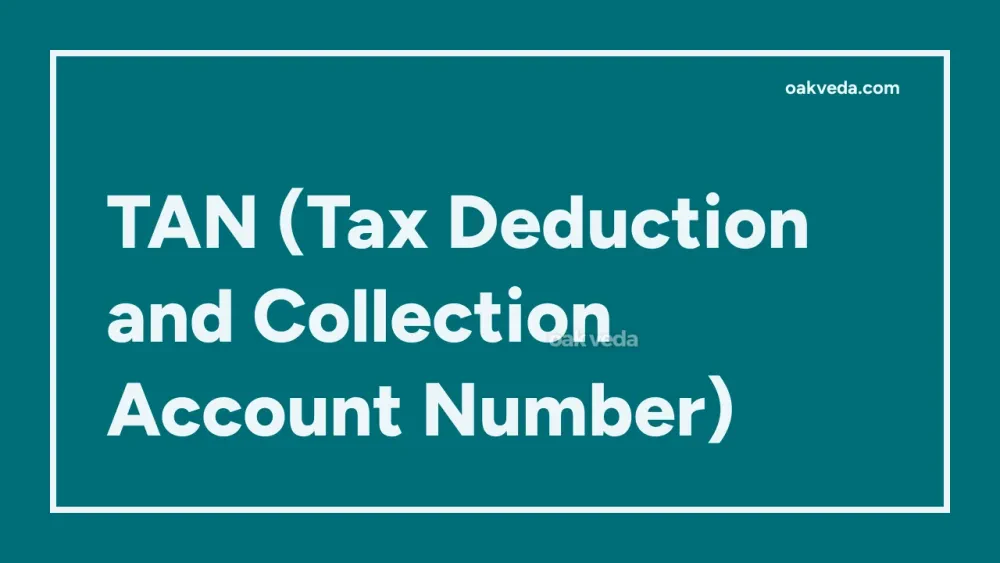
What is the Full Form of TAN?
The full form of TAN is Tax Deduction and Collection Account Number. This unique identifier plays a crucial role in the Indian taxation system, facilitating the process of tax deduction and collection for both individuals and businesses.
What is Tax Deduction and Collection Account Number?
Tax Deduction and Collection Account Number, commonly known as TAN, is a 10-digit alphanumeric code issued by the Indian Income Tax Department. It is mandatory for all entities responsible for deducting or collecting tax at source. This includes employers, companies, and other organizations that make specific types of payments subject to Tax Deducted at Source (TDS) or Tax Collected at Source (TCS).
Origin and Development of TAN
The concept of TAN was introduced under Section 203A of the Income Tax Act, 1961. Its primary purpose was to streamline the tax deduction and collection process, ensuring better tracking and accountability of tax-related transactions. Over the years, the system has evolved to become an integral part of India's tax administration framework.
How does TAN work?
TAN serves as a unique identifier for entities involved in tax deduction or collection. When a payment subject to TDS or TCS is made, the deductor or collector must quote their TAN in all related documents and communications with the Income Tax Department. This includes TDS returns, TCS returns, and tax payment challans.
The system works as follows:
- Entities obtain a TAN from the Income Tax Department
- They use this TAN when deducting or collecting tax
- All tax payments and returns are filed using the assigned TAN
- The Income Tax Department uses TAN to track and reconcile tax transactions
Functions of TAN
The Tax Deduction and Collection Account Number serves several important functions:
- Unique Identification: It provides a distinct identity to each tax deductor or collector.
- Tracking: Enables the Income Tax Department to monitor tax deductions and collections efficiently.
- Compliance: Ensures that entities fulfill their tax obligations correctly and timely.
- Reconciliation: Facilitates the matching of tax payments with corresponding deductions or collections.
- Refund Processing: Helps in processing tax refunds more accurately and quickly.
Applications of TAN
TAN finds application in various scenarios within the Indian taxation system:
- Salary Payments: Employers use TAN when deducting tax from employees' salaries.
- Professional Services: Businesses quote TAN when paying for professional services and deducting TDS.
- Rent Payments: Tenants use TAN when deducting tax on rent paid to landlords.
- Contract Payments: Companies use TAN when making payments to contractors and deducting applicable taxes.
- Interest Payments: Banks and financial institutions use TAN when deducting tax on interest payments to account holders.
Features of TAN
The Tax Deduction and Collection Account Number has several distinctive features:
- Alphanumeric Structure: TAN is a 10-character code consisting of both letters and numbers.
- Jurisdiction Code: The first four characters represent the jurisdiction code of the Income Tax Department.
- Unique Identifier: The remaining six characters are unique to each entity.
- Mandatory Requirement: It is compulsory for all entities involved in tax deduction or collection.
- Permanent Nature: Once issued, TAN remains valid unless cancelled or surrendered.
Benefits of TAN
Implementing the TAN system offers numerous benefits:
- Improved Compliance: Encourages timely and accurate tax deductions and payments.
- Efficient Monitoring: Allows the tax authorities to track tax transactions effectively.
- Faster Processing: Facilitates quicker processing of tax returns and refunds.
- Reduced Errors: Minimizes mistakes in tax filings and payments through standardized identification.
- Enhanced Transparency: Promotes transparency in tax-related transactions.
Limitations or Challenges of TAN
While TAN is an essential tool in tax administration, it does face some challenges:
- Application Process: Obtaining a TAN can be time-consuming for some entities.
- Penalties for Non-compliance: Failure to obtain or quote TAN correctly can result in penalties.
- Multiple TANs: Some entities may inadvertently obtain multiple TANs, leading to confusion.
- Updating Information: Keeping TAN-related information up-to-date can be challenging for some organizations.
Future Developments in TAN Technology
The Indian Income Tax Department continually works on improving the TAN system. Future developments may include:
- Digital Integration: Further integration with digital platforms for seamless tax processes.
- AI-powered Verification: Implementation of artificial intelligence for faster verification and processing.
- Real-time Tracking: Enhanced real-time tracking capabilities for tax deductions and collections.
- Mobile Applications: Development of mobile apps for easy TAN-related transactions and updates.
FAQs on TAN Full Form
-
How can I apply for a TAN? You can apply for a TAN by submitting Form 49B either online through the NSDL e-Gov website or offline at TIN Facilitation Centers.
-
Is TAN different from PAN? Yes, TAN (Tax Deduction and Collection Account Number) is different from PAN (Permanent Account Number). PAN is for individual taxpayers, while TAN is for entities responsible for deducting or collecting tax.
-
Can an individual have multiple TANs? No, an entity should have only one TAN. Having multiple TANs is not allowed and can lead to complications.
-
What happens if I don't obtain a TAN? Failure to obtain a TAN when required can result in penalties under Section 272BB of the Income Tax Act.
-
How long does it take to get a TAN? Typically, it takes about 7-10 working days to receive a TAN after submitting the application.
Understanding the full form and significance of TAN is crucial for businesses and individuals involved in tax deduction and collection in India. By adhering to TAN regulations, entities can ensure smooth tax compliance and contribute to an efficient taxation system.
You may be interested in:

